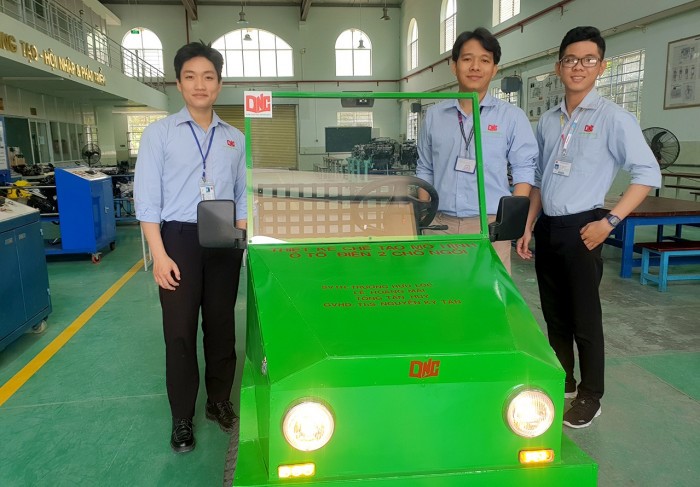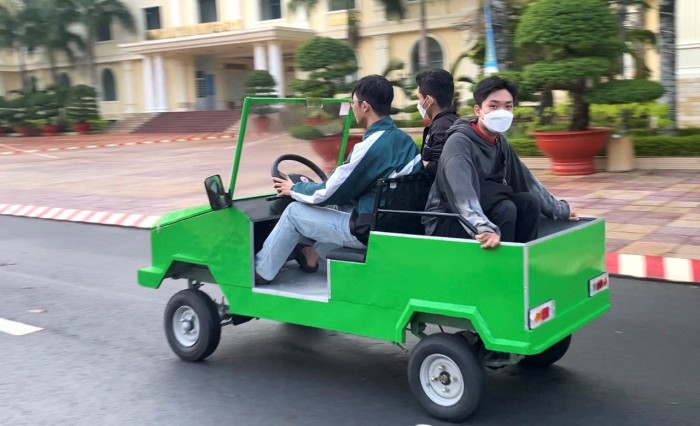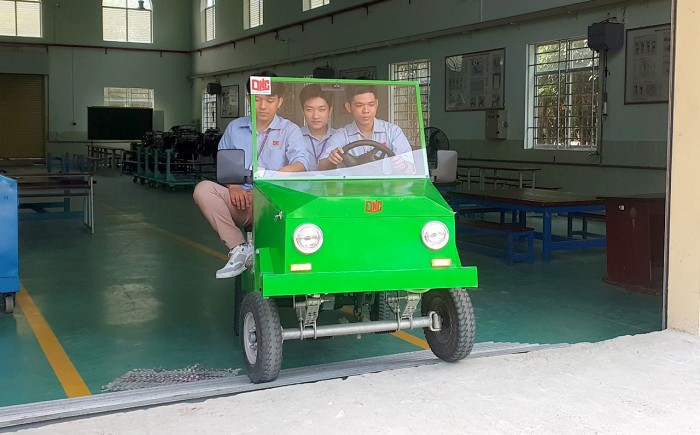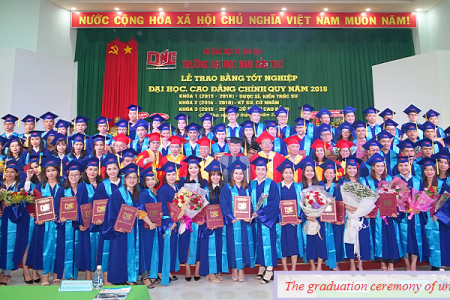Aug 20,2023
baogiaothong.vn: Three students built cheap electric cars
THREE STUDENTS BUILT CHEAP ELECTRIC CARS
Making an electric car is not a terrible prospect for professional firms, but for students sitting in university chairs it is a completely different story.
The dream of an electric car that is ten times cheaper than the market price of three male students from Nam Can Tho University was gradually coming true.
Three months of tinkering

Three male students (from left to right) Mai, Loc, and Huy with a homemade electric car model
At the end of July, a two-seat electric car model, the graduation project of Truong Huu Loc, Le Hoang Mai and Tong Tan Huy, three fourth-year students from the Faculty of Mechanical Engineering, Automotive Engineering Technology at Nam Can Tho University (Can Tho), won the highest mark in front of the defense council.
Assoc. Dr. Ly Hung Anh, from the University of Science and Technology at the VNU-HCM, and a member of the ASEAN NCAP Technical Council said: “This car is possible for use in a small area, such as for cargo or private purposes, but to be able to run on the street, it must definitely meet the conditions of production, assembly, and technical safety of vehicles. The scientific research of students and teachers is the basic foundation. To be able to raise the level of commercialization is a very long step, and it requires a lot of effort from many sides, such as investment from businesses. Some universities now have business incubation centers, which are intended to support the commercialization of in-university research.”
“When the students defended their graduation project in front of the university council, engineers from Tra Vinh University and Can Tho University highly praised the applicability of this product,” said Mr. Nguyen Van Tong Em (MSc), Vice Dean of the Faculty of Mechanical and Engineering at Nam Can Tho University.
Student Truong Huu Loc said that he, along with Mai and Huy, were both very fond of and passionate about cars. When choosing a topic for the graduation project, all three agreed to choose the topic of designing and manufacturing two-seat electric cars. With their accumulated knowledge, they asked the teacher for help when they encountered difficulties, found out more models online, and the whole group was determined to put their hands to the task.
Each person was assigned a job: Loc was responsible for coming up with the design ideas and electrical systems, while Mai and Huy shared the task of making the rib frame, roaring machine, engine, and deploying from software.
After tinkering for three months, working non-stop, the new electric car was completed with a length of over 2.5 m, a width of almost 1 m, a ground clearance of 11 cm, and a turning radius of 3.62 m. The car body and frame were made of iron and painted with green, environmentally- friendly paint.
The car was fully equipped with the same features as other conventional electric cars, including normal driving modes, heavy load, and reverse gear.
Equipment such as lights, turn signals, accelerator pedals, brake pedals, a trunk, and a windshield were adequately equipped and easy to use. The car was also designed with two shock absorbers, which can carry hundreds of kilograms while still functioning properly.
According to the group of students, this car's features are not too dissimilar from other electric cars, as there are common technical standards. The only difference is that the car has an extra handbrake, which, when pulled, prevents the car from running.
The day when the compact and unique car was operated on the university yard without any problems, the whole group was so happy that they wanted to cry.
Multi-purpose car model

The electric car designed and manufactured by a group of students from the Nam Can Tho University has a length of more than 2.5 m and a width of nearly 1 m and can operate continuously for about 40 km, with a maximum speed of 40 km/h
Dr. Tran Huu Xinh, Vice Rector of Nam Can Tho University, said that the electric car of the three male students had been decided by the Can Tho City People's Committee to recognize the effectiveness of the application and the scope of the initiative's influence within the City and nationwide.
“Currently, this electric car is being used by the university to transport documents, drinking water, and to travel around the campus. Its applicability is possible, but initially it can only be used within the internal area of the university. To be used in other conditions or running on the road, other standards must be met," said Dr. Xinh.
According to Dr. Xinh, this electric car is very versatile; in addition to being used for commuting, it can be used to transport goods, especially for large farms with high transportation needs. Compared to model cars using gasoline engines, this electric car helps save a lot of costs in the process of agricultural production.
The university has an orientation for three male students to study for a Master's degree to continue developing this model. Dr. Xinh stated that the university would provide maximum support for this model car to be applied in practice.”
Mr. Le Hai Phuc, Director of Ong De Tourist Village (Can Tho), reported that his company recently bought several electric cars that can carry 6-9 people to transport guests from Nguyen Van Cu Street to the tourist area, each new car costing over 300 million VND. Upon hearing about the electric car of students of Nam Can Tho University, which was successfully built for only about 30 million VND per car, he came to investigate.
“The current price of electric cars is not cheap, with the new purchase price of 300 million VND per 14-seat car and 4-seat car 160 million VND per car. If the students of Nam Can Tho University can make electric cars at a particularly low price, with good quality and design, my resort is ready to buy many," said Mr. Phuc. He added that Can Tho has dozens of tourist areas and attractions, so the potential for low-cost electric cars is quite large.
Telling for the future

Electric cars can easily climb up the slopes with three people
Huy and Mai, two members of the team, said that the process of building this electric car for the first time took three months. However, they can now do it better in just over a month because they have gained a lot of experience.
With the current car model, the students said they had spent approximately 20 million VND, with the highest cost being the electric motor and battery. To make the car more complete, they need an additional 10 million VND.
This is probably the most advantageous point of the "student" car. Two-seater electric cars of the cheapest Chinese brands can cost up to nearly 50 million VND, while Thai cars range from 75 to 200 million VND (excluding import costs).
“Loc introduced that they could make the trunk wider and add a roof. The engine power of 850 W, equivalent to 1.14 HP is strong enough. The car takes about 5 hours to fully charge the battery and can operate continuously for about 40 km, with a maximum speed of 40 km/h."
The expectation for the electric car is increasing day by day, motivating the three students to work and create. Loc said that the group also cherished this car, as it not only carries pepole but can also help farmers transport fertilizers and agricultural products to save production costs. “When it was not completed,” said Loc, “we carried five bags of fertilizer, each weighing 50 kg, for a total weight of 250 kg, and the car still operated well. We also tested the load with six adults, and the car operated without any problems."
In the minds of these three male students, this was no longer just a graduation project, marking the achievement of their four years of study. When they saw the car running, the students had big and far-reaching dreams.
Therefore, in addition to that Nam Can Tho University promoting the procedure to be able to turn this car into a University commodity, the target of the university and its students will not only be in tourist areas, but can be improved to provide the units with licenses to operate electric cars on the road.
When is it sold and circulated in the streets?
The Can Tho Department of Transport said that currently, electric cars carrying tourists in Can Tho are allowed to be piloted by the Prime Minister, but within a limited scope. According to current regulations, electric cars must be equipped with a cruise monitoring device, and the driver must have a corresponding driving license. The manufacturer must design, register, operate, and participate in traffic in accordance with the Road Traffic Law.
The director of a registration center in Hau Giang said that for the three students’ electric cars, in order to have practical applications, they must be registered at the National Office of Intellectual Property (Ministry of Science and Technology) and the Vietnam Register Department to certify the model like a normal vehicle, so that it is eligible to be sold and to apply for a circulation permit.
“For electric cars, the first 36 months will not required registration. Then, depending on the type of car, it must be registered locally," this person said.
Nguyen Viet
Source: https://www.baogiaothong.vn/ba-sinh-vien-che-tao-o-to-dien-gia-re-d600954.html



